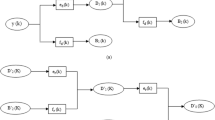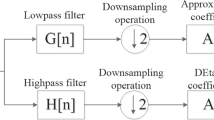Abstract
In this paper, a new Watermarking method based on the optimization framework and discrete wavelet transform (DWT) is presented. In this method, first, the watermark image is divided into several blocks. Then, using differential evolution (DE) algorithm, an appropriate location for each of these blocks is found in the cover image. In the proposed method, the results of the DE algorithm, which is needed for the reconstruction phase are also embedded as a vector in the cover image under the wavelet domain. Also, to achieve the highest PSNR in the reconstruction phase, the optimal values for Alpha-blending coefficients (used in the embedding and extraction process) are determined with the multi-objective DE-based optimization algorithm. Several experiments are presented to illustrate the imperceptibility and robustness of the proposed algorithm against different types of attacks, including salt and pepper, Gaussian, median filtering, rescaling, compression, and rotation. The obtained results are also compared with state-of-the-art methods and show the superiority of the proposed method in most cases.










Similar content being viewed by others
References
AL-Nabhani Y, Jalab HA, Wahid A, Noor RM (2015) Robust watermarking algorithm for digital images using discrete wavelet and probabilistic neural network. J King Saud Univ Comput Inf Sci 27(4):393–401
Alotaibi RA, Elrefaei LA (2019) Text-image watermarking based on integer wavelet transform (IWT) and discrete cosine transform (DCT). Applied Computing and Informatics 15(2):191–202
Chang Z, Cao J, Zhang Y (2018) A novel image segmentation approach for wood plate surface defect classification through convex optimization. J For Res 29(6):1789–1795
Chen Z, Li L, Peng H, Liu Y, Yang Y (2018) A novel digital watermarking based on general non-negative matrix factorization. IEEE Trans Multimedia 20(8):1973–1986
Ernawan F, Kabir MN (2018) A robust image watermarking technique with an optimal DCT-Psychovisual threshold. IEEE Access 6:20464–20480
Ernawan F, Kabir MN (2018) A block-based RDWT-SVD image watermarking method using human visual system characteristics. The Visual Computer 1–19. https://doi.org/10.1007/s00371-018-1567-x
Fan F, Liu R (2018) Exploration of spatial and temporal characteristics of PM2. 5 concentration in Guangzhou, China using wavelet analysis and modified land use regression model. Geo Spat Inf Sci 21(4):311–321
Fatahbeygi A, Akhlaghian Tab F (2019) A highly robust and secure image watermarking based on classification and visual cryptography. Journal of Information Security and Applications 45:71–78
Gangadhar Y, Akula VGS, Reddy PC (2018) An evolutionary programming approach for securing medical images using watermarking scheme in invariant discrete wavelet transformation. Biomed Signal Process Control 43:31–40
Ghafoor A, Imran M (2012) A non-blind color image watermarking scheme resistant against geometric attacks. Radioengineering 21(4):1246–1251
Jagadeesh B, Kumar PR, Reddy PC (2015) Fuzzy inference system based robust digital image watermarking technique using discrete cosine transform. Procedia Comput Sci 46:1618–1625
Liu XL, Lin CC, Yuan SM (2018) Blind dual watermarking for color images’ authentication and copyright Protection.IEEE. Trans Circuits Syst Video Technol 28(5):1047–1055
Moosazadeh M, Ekbatanifard G (2019) A new DCT-based robust image watermarking method using teaching-learning-based optimization. Journal of Information Security and Applications 47:28–38
Ramamurthy N, Varadarajan S (2013) The robust digital image watermarking scheme with back propagation neural network in DWT domain. Int J Comput Sci Network Security 13(1):111–117
Rasti P, Samiei S, Agoyi M, Escalera S, Anbarjafari G (2016) Robust non-blind color video watermarking using QR decomposition and entropy analysis. J Vis Commun Image Represent 38:838–847
Seetha C, Goollawattanaporn S, Tanprasert C (2013) Transparent digital watermark on Drug's images. Procedia Comput Sci 21:302–309
Singh RK, Shaw DK, Alam MJ (2015) Experimental studies of LSB watermarking with different noise. Procedia Comput Sci 54:612–620
Singh AK, Kumar B, Singh SK, Ghrera SP, Mohan A (2018) Multiple watermarking technique for securing online social network contents using Back propagation neural network. Future Gener Comput Syst 86:926–939
Storn R, Price K (1997) Differential evolution–a simple and efficient heuristic for global optimization over continuous spaces. J Glob Optim 11(4):341–359
Taheri A (2014) An adaptive digital image watermarking based on image features in discrete wavelet transform domain and general regression neural network. Int J Enhanc Res Sci Technol Eng 3(10):184–191
Tan Y, Qin J, Xiang X, Ma W, Pan W, Xiong NN (2019) A robust watermarking scheme in YCbCr color space based on channel coding. IEEE Access 7:25026–25036
Thanki R, Kothari A, Trivedi D (2019) Hybrid and blind watermarking scheme in DCuT–RDWT domain. Journal of Information Security and Applications 46:231–249
Yao Y, Zhang W, Wang H, Zhou H, Yu N (2019) Content-adaptive reversible visible watermarking in encrypted images. Signal Processing 164:386–401
Yuefeng Z, Li L (2015) Digital image watermarking algorithms based on dual transform domain and self-recovery. International Journal On Smart Sensing And Intelligent Systems 8(1):199–219
Zear A, Singh AK, Kumar P (2018) A proposed secure multiple watermarking technique based on DWT, DCT and SVD for application in medicine. Multimed Tools Appl 77(4):4863–4882
Author information
Authors and Affiliations
Corresponding author
Additional information
Publisher’s note
Springer Nature remains neutral with regard to jurisdictional claims in published maps and institutional affiliations.
Rights and permissions
About this article
Cite this article
Salimi, L., Haghighi, A. & Fathi, A. A novel watermarking method based on differential evolutionary algorithm and wavelet transform. Multimed Tools Appl 79, 11357–11374 (2020). https://doi.org/10.1007/s11042-019-08455-7
Received:
Revised:
Accepted:
Published:
Issue Date:
DOI: https://doi.org/10.1007/s11042-019-08455-7




